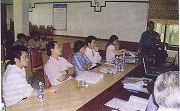- Home
- Technical Cooperation Projects
- Index of Countries
- Asia
- Viet Nam
- Improvement of Port Management System in the Socialist Republic of Vietnam
- Project News
- An article published in Vietnam Maritime Magazine concerning this project
Project News
2006-02-09
An article published in Vietnam Maritime Magazine concerning this project
An article published in Vietnam Maritime Magazine concerning this project
- Technical assistant Project for the Improvement of Port Management System in Vietnam -
(Source: Vietnam Maritime Magazine 10-2005 issued by Vinamarine)

The Port Management System Improvement Project funded by JICA has been implemented by the OCDI. And this article, Mr. Le Vu Khanh, Director of the Infrastructure Management Dept., Vinamarine will give brief information about the Project.
Reporter (R): What contents and issues does the Project cover? Do you think that we can learn and apply to Vietnam’s situation?
Mr. Le Vu Khanh (LVK): The Port Management System Improvement Project, in which the operation of the Japanese side is funded by JICA, aims at improving state management and operation capacity for Vinamarine personnel through the experience and knowledge transferred from Japanese experts. Contents of the project concentrate in what Vietnam’s side needs such as: the introduction of non-state sector participation in port infrastructure investment and operation, essential legal and institutional conditions for effective operation of port infrastructure. We can say that the coverage of the project is practical, especially while we are shifting to market-oriented economy with the participation of multi-components. During the project, the OCDI’s experts shall give lectures to Vinamarine’s staff on issues regarding foreign port management models, with analysis of strong points, weak points of each model and emphasis on the attraction of non-state sector to port construction and operation to ease the State’s investment and administration burden. The OCDI’s experts and Vietnam’s counterpart will analyze Vietnam’s conditions (particularly the conditions of Cai Mep- Thi Vai port) in order to develop an appropriate port management model that match with Vietnam’s characteristics and promote strong points of a modern management model applied in Vietnam, and firstly in Cai Mep- Thi Vai port. In general, all the knowledge transfer by Japanese experts and issued raised for analysis are highly practical and need to be researched and applied in port management situation in Vietnam.
(Photo:Mr. Le Vu Khanh, Director of the Infrastructure Management Dept., Vinamarine )

R: As the member of the project from its very first days (February 2005), what do you intend to turn provided “materials” into detailed policy? What is your proposal?
LVK: From the general knowledge and theory to detailed theory is a long way. However, the ideas of the port management model that Japanese experts have been introducing are not totally new in Vietnam. In Decision No.202/QD-TTg dated December 12th, 1999 by the Prime Minister on the approval of the Port System Development Master Plan to 2010, some similar ideas can be found: “the investors have the rights of port management and operation to recover their investment” (Item 4, Article 2). Decision No.228/2003/QD-TTg on the pilot scheme of leasing Cai Lan port is a further step aiming at encouraging every economic sector to invest, construct and operate port infrastructure. This is the foundation to turn ideas into policy, and later policy into detailed regulations. Firstly, maybe we should start from the amendment of Decree 160 of the Government, within the agenda for compiling and revising under-law documents after the National Assembly has passed the new Maritime Code which comes into force from January 1st, 2006. We need the regulation of the above-mentioned revised Decree to allow the establishment of a new management mechanism aiming separating port ownership’s roles away from port operation’s roles, separating regulation and monitoring roles away from service providing functions, and the core of the issue is establishing a Port Management Body. And next steps will be creating new thinking ways and a new port management model.
R: One-year implementation of Cailan’s pilot leasing scheme must have produced optimistic outcomes which encourages Vinamarine to further carry out the leasing-out proposal of three ports Quy Nhon, Nha Trang and Nghe Tinh. During the implementation course, what obstacles have you found to set as experience lessons?
LVK: As I have said, the Prime Minister has issued Decision no.228/2003 approving pilot leasing scheme for Cailan port in Quang Ninh. After one-year implementation, the Ministry of Transport, on last September 12, organized the preliminary meeting on one-year contract execution. After listening to all representatives’ contributive ideas at the meeting, Mr. Vuong Dinh Lam, Chairman of Vietnam maritime Administration, on behalf of delegation President, withdrew some significant conclusions as follows:
This model cements the responsibility relations between lesser and lessee side;
The 2 sides have closely cooperated to attain effectiveness in Cailan port exploitation;
Being a lessee, the operator side has analyzed, formulated short term and long term development plans in accordance with domestic as well as regional market;
This contract has obeyed the principle that investor holds the right to recover his capital for reinvestment;
After nation-wide application, this model would create fairness among enterprises.
Despite the fact that the pilot leasing scheme has just been implemented for 1 year, Cailan port’s model of management and exploitation has proved to be on its right track with initial success, and therefore, it is worth applying to other ports over the country with a view to bringing a common and fair arena among port enterprises. Because of the fact that this is the pilot infrastructure leasing scheme in which lesser was designated, Cailan contract has not yet fully developed its strengths as it intended. Once applied to other ports, such as Nghe Tinh, Quy Nhon and Nha Trang ports in the first stage, we may meet with similar opportunities and challenges as those in the case of Cailan port. Therefore, infrastructure leasing model application must take into account both general and specific conditions of each port. It also means that we have to apply an advanced management model with orientation of open trade and free competition for all economic sectors in Vietnam’s transition economy. Also under this circumstance, the infrastructure leasing scheme applied to above-mentioned ports should be placed in overall conversion of organization structure, ownership as well as management forms of port enterprises.
R: Thank you Sir
(Photo:'A lecture for members of Vietnam's taskforce organized in Vinamarine within the Port Management System Improvement Project' )
- About JICA
- News & Features
- Countries & Regions
- Our Work
- Thematic Issues
- Types of Assistance
- Partnerships with Other Development Partners
- Climate Change / Environmental and Social Considerations
- Evaluations
- Compliance and Anti-corruption
- Science and Technology Cooperation on Global Issues
- Research
- JICA Development Studies Program / JICA Chair
- Support for the Acceptance of Foreign HRs / Multicultural and Inclusive Community
- Publications
- Investor Relations
